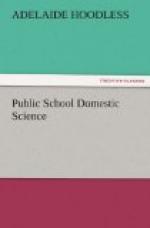COFFEE.
Coffee is made from the berries of coffee-arabica, which are dried, roasted and browned. The following table gives an approximate idea of the composition of coffee beans (Konig):—
Water 1.15 Fat 14.48 Crude fibre 19.89 Ash (mineral matter) 4.75 Caffeine 1.24 Albuminoids 13.98 Other nitrogenous matter 45.09 Sugar, gum and dextrin 1.66
Coffee is frequently adulterated with chicory, which is harmless. Coffee should not be allowed to boil long or stand in the coffee pot over a fire, as the tannin is extracted, which renders it more indigestible. Much controversy has been indulged in over the effect of coffee upon the system, but like many other similar questions it has not reached a practical solution. The general opinion seems to be that when properly made and used in moderation it is a valuable stimulant and not harmful to adults.
COCOA.
Cocoa and chocolate contain more food substances than tea or coffee, although their use in this respect is not of much value. The following table gives the analysis of cocoa (Stutzer):—
Theobromine 1.73 Total nitrogenous substance 19.28 Fat 30.51 Water 3.83 Ash (mineral matter) 8.30 Fibre and non-nitrogenous extract 37.48
ALCOHOL.
The use of alcohol is wholly unnecessary for the health of the human organism. (See Public School Physiology and Temperance.)
Condiments.
Condiments and spices are used as food adjuncts; they supply little nourishment, the effect being mainly stimulating, and are very injurious when used in excess. They add flavor to food and relieve monotony of diet. The use of such condiments as pepper, curry, pickles, vinegar and mustard, if abused, is decidedly harmful. Salt is the only necessary condiment, for reasons given in the chapter on mineral matter. The blending of flavors so as to make food more palatable without being injured is one of the fine arts in cookery. Some flavors, such as lemon juice, vinegar, etc., increase the solvent properties of the gastric juice, making certain foods more digestible.
CHAPTER IX.
Preparing Food.
The knowledge of food values and their relation to the body will be of little use for practical purposes unless combined with the knowledge of how the various foods should be prepared, either by cooking or in whatever form circumstances and the material may require. The first requisite for cooking purposes is heat; this necessitates the use of fuel. The fuels chiefly used for household purposes are wood, coal, kerosene oil and gas. Soft woods, such as pine or birch, are best for kindling and for a quick fire. Hard woods, oak, ash, etc., burn more slowly, retain the heat longer, and are better adapted for cooking purposes.




